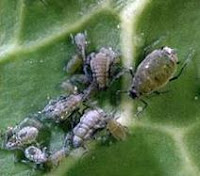
Black Widow Spider
The female black widow spider, distinguished by the red hourglass marking on the underside of her abdomen, is probably the best known and most feared of all North American spiders. In spite of the female black widow’s small size of 1.2 cm (0.5 in.), its venom is quite toxic and may cause a wide range of symptoms in humans, including pain, swelling, nausea, and sometimes death. The male of this species is harmless to humans and lacks the hourglass marking on the abdomen.

Blue Spotted Sea Urchin
This underside view of the blue spotted sea urchin shows its mouth apparatus, commonly called Aristotle’s lantern. This structure is composed of five jaws arranged in a radial, or concentric, pattern. This arrangement allows the sea urchin to feed efficiently on a variety of marine algae and kelps.

Branching Coral Colonies
Branching coral is actually a colony of very small individual animals called coral polyps. Branching corals are considered hard corals, since they have a hard calcium carbonate skeleton. Their bright colors result from the presence of symbiotic algae that live in their body tissues and produce most of the food that the coral needs to survive.

Chambered Nautilus
A cutaway view of the shell of the chambered nautilus reveals the compartments that housed the nautilus when it was smaller. These smaller chambers, now connected together by a small calcified tube, regulate the buoyancy of the nautilus as it swims along. The compartments are filled with nitrogen gas, which is produced by the nautilus.

Clams
Clams have long been one of the most popular of the edible shellfish. Referred to as bivalve mollusks because of the two valves, or shells, that enclose the body, these small filter-feeding animals are commonly found in intertidal areas throughout the world. Strong internal muscles, a hinge ligament, and a calcified hinge at the apex of the shell allow the clam to protect itself against many types of predators by keeping the shell tightly closed. The prominent growth rings found on the outer surface of the clam shell are useful in determining the clam’s age.

Common Cuttlefish
Related to the octopus and squid, the common cuttlefish is an open water species of cephalopod mollusk that swims by undulating a continuous fin along the length of its short, fat body. The cuttlefish is commercially important throughout many parts of its range. A supporting rod of calcium carbonate present within the cuttlefish, called cuttlebone, is used commercially as a polishing agent and as a source of calcium and salts for captive birds and other animals.

Common Octopus
The common octopus has the typical octopus body form consisting of three main regions: the mantle, limbs, and head. The mantle, a large, muscular, bulbous sac, contains most of the internal organs, including the gills, digestive tract, ink sac, and reproductive organs. The limbs consist of eight arms. Along the length of each arm is a double row of suckers equipped with tactile and olfactory receptors.

Earthworm
Earthworms have a segmented, compartmentalized, cylindrical body and range in length from several centimeters (a few inches) to nearly 3.3 m (11 ft). They have no eyes, ears, or lungs. Earthworms breathe when air that is present between soil particles diffuses through their thin skins, and they are forced to the surface if these air pockets fill with rainwater. When a worm moves, it uses its longitudinal muscles to extend the front of its body into the soil ahead of it, pulling the back part up behind it. Setae, tiny projections from each segment of the worm, stick into the surrounding soil to keep the worm from slipping. The digging action of earthworms helps to aerate and mix the soil. Earthworms actually consume some of the soil as they dig, and their fecal deposits, called castings, also help enrich the soil.

Echinoderms
Members of the phylum Echinodermata, commonly called echinoderms, or spiny-skinned animals, are so named because of their spiny outer body coverings. Echinoderms differ from other animals in that they have a water vascular system that uses seawater to accomplish respiration, locomotion, and reproduction. The echinoderms include marine groups such as the sea stars (top, left), sea cucumbers (bottom, left), brittle or serpent stars (top, center), sand dollars (bottom, center), sea lilies (right), sea urchins, basket stars, heart urchins, and feather stars.




































